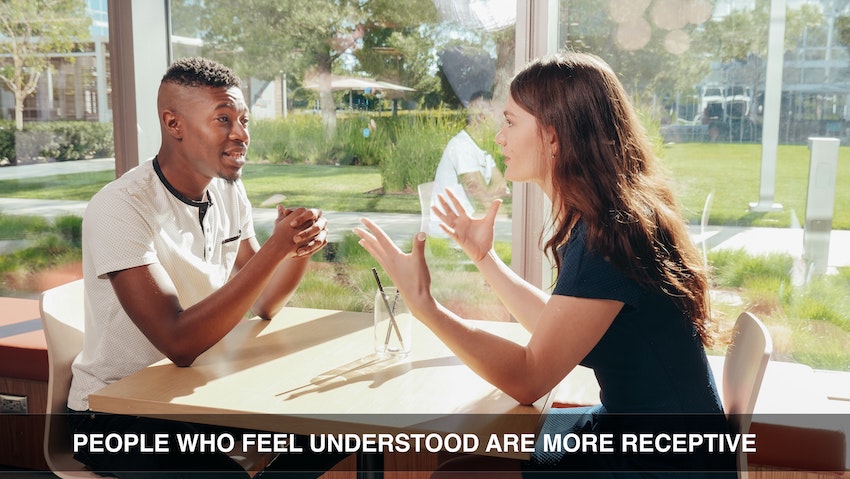How To Manage Change In The Workplace
Proven Tips To Master Change Management
Refine your communication skills by learning to harness your emotional intelligence with one of the UK's most acclaimed management training courses.
Why Choose This Training?
More Than Just A Course Of Lectures
What gets in the way of developing and holding on to new communication skills are old habits of thinking and speaking. Even if the advice is very good the reason why it rarely sticks are the mental habits people inevitably revert to, especially under pressure.
Unlearning those old habits and internalising a more effective and lasting approach to communication needs more than a short course of lectures on how to do it.
What Makes This Training Stand Out?
What makes this training stand out is the exceptional support through one-to-one coaching sessions and continuous feedback. Changing behaviour is not an easy task as old habits are hard to break.
With a 40-year track record we can help you cultivate practical skills, and build your confidence to so you can successfully navigate real-world challenges, ensuring lasting behavioural improvements.
Testimonials
Join thousands of participants getting results
"What I love about this course is that I didn't just learn about the topic, this course is about ME. I'm confident I can reliably use my new skills, even when under pressure".
![]()
"A lesson for life! The power of effective communication is incredible when one masters the skills "listening with empathy" and "speaking assertively"
![]()
Clients We Have Worked With
Well-known companies who have used this course again and again, over many years
Course Summary
Training Objectives
Managing change at work can feel like a huge challenge. Studies show that businesses who handle change well are more likely to succeed. This training course breaks down simple steps to help you manage change effectively, making the process smoother for everyone involved. Here are some of the best practices for change management.
- Change in the workplace is like a tide; it's always coming. It involves new ways of working, technology updates, and shifts in leadership.
- Communication is crucial for handling change well. Sharing information clearly and listening to employees helps everyone adapt smoother.
- Including all team members in planning change makes them feel valued and less likely to resist new ways.
- Setting clear goals guides the change process, making sure everyone knows what they are working towards.
- Supporting employees through changes keeps their morale high. This means understanding their feelings, encouraging open chat, and offering help when needed.
Develop Your Emotional Intelligence
You will learn a set of powerful emotional intelligence communication techniques so that you can manage difficult conversations, handle challenging situations, build relationships and set firm boundaries.
Transferable Skills
The goal of this training is to equip you with the tools you need to build strong, lasting relationships in your professional life, although because these skills are so transferable many clients report vast improvements in their personal relationships as well.
Develop Skills
This is a skills development rather than just a theoretical programme, so the emphasis throughout will be on you taking turn after turn, practising your skills, while receiving feedback and coaching about your effect on others.
Repeated Practice and Feedback
In your coaching sessions you will be helped to practise dealing with the kinds of situation you find challenging, again and again, until you are confident you can do it successfully.
Video Analysis
We'll combine practical, hands-on experience with video replay and analysis and discussion of the principles involved to help you gain both skills and understanding. Special attention is paid to your individual training needs, so you can practise your skills in real-life situations that you have to handle at work.
Sustained Change
That's why as well as your place in a small group, this training includes a generous amount of private and confidential one-to-one coaching sessions online, spread over several months, ensuring an exceptional level of support. This will ensure the changes you make are sustained over a longer period of time and any obstacles are overcome. Choose between online training available worldwide, or in-person face-to-face courses in the UK.
Course Dates and Price
For a list of upcoming course dates (for online coaching and face-to-face training), the locations of the next 3-day public courses in the UK and pricing Click here.
Free Initial Session
This initial coaching session serves as an introduction to the "Skills with People" course, allowing you to understand the course's relevance and effectiveness for your specific needs before committing to it.

Understanding Organisational Change
Change in the workplace ... it's like a tide, always coming and going. It happens when companies need to grow or adjust to new ways of working.
Definition of change
In the workplace, change means making something different than it was. This could involve new methods, leadership shifts, or updating technology. It's about moving from an old way to a newer, hopefully better one.
Change is constant and happens in every part of a company's culture. It affects how people work together, use resources, and achieve goals.
Organisational change isn't just about swapping out tools or bringing in fresh faces. It digs deep into the fabric of a company – altering procedures, mindsets, and even the organisational structure itself.
These shifts are crucial for staying ahead in today’s fast-moving world but can unsettle employees and disrupt workflows if not handled with care.
Drivers of change in the workplace
Now that we've defined what change is, let's explore why it happens in the workplace. New technologies often kick-start changes. Companies want to stay ahead, so they bring in new tools and systems.
This demands employees to learn new skills or even change how they work daily.
Market trends play a big part too. If customers start wanting different things, businesses have to shift gears. They might need to make new products or tweak the old ones. This can lead to changing roles for team members or bringing in fresh faces with different talents.
Plus, company goals can change over time – aiming for more growth or entering new markets requires everyone to adjust and embrace these shifts together.

The Importance of Managing Change
Managing change well is key to keeping your team happy and the business running smooth. It helps everyone adapt faster, reducing stress and bumps along the way.
Impact on employees
Change in the workplace can stir up lots of feelings among employees. It could be worry about new tasks or fear of losing their job. Sometimes, they might feel excited for a fresh start.
But often, it's a mix that leans more towards stress and confusion. Employees need to know what's happening to feel secure and supported.
Strong support during change keeps employee engagement high. They want clear communication and to be part of the process. When workers understand how changes benefit them and the company, they're more likely to get on board.
This makes them less resistant and helps everyone move forward together.
Impact on business performance
Just as change affects employees, it also has a big impact on how a business performs. A well-handled change process can lead to improved productivity, innovation, and competitiveness.
Businesses that effectively manage change often see better results. They adapt faster to new markets and technologies. This keeps them ahead of others who stick to old ways.
Ignoring the need for change can hurt a company's bottom line. Sales might drop, and talented workers could leave for more dynamic places. But when businesses embrace change, they grow stronger.
They find new chances to make money and improve their standing in the market. Managing organisational change well means staying relevant in a fast-moving world.

How to Approach Change Management
Navigating change management is a bit like planning a journey; you need to know where you're starting from and where you aim to reach. It's about plotting the course, with readiness for detours and surprises along the way. Here are some tips for leading change initiatives.
Understand the process of change
To grasp change in the workplace, think of it as a journey. It has a start, middle, and end. The beginning involves realising why change is needed. This could be due to new processes or because the work environment demands it.
The middle part is all about what happens during the change—like learning new skills or adapting to different roles. Finally, reaching the end means successfully implementing the change.
Next, spotting where this shift comes from gets crucial. Whether it's internal desires for better performance or external drives like market demand changes—it's vital to identify these forces early on.
Identify the forces of change
Spotting the forces of change is like putting together a puzzle. It involves looking at what's happening inside and outside your workplace. Inside, you might see new technology rolling out or shifts in company culture.
Outside, changes could come from market trends, customer demands, or even global events. Each piece affects how we work and adapt.
Understanding these forces helps us prepare for what's next. We ask questions, dive into details, and map out the impact on our jobs and teams. This way, we're not caught off guard when change comes knocking.
By being proactive, we keep ahead of the game – making sure that managing change becomes part of how we operate every day.
Create a plan
After identifying the forces of change, it's crucial to create a plan. This plan sets out the steps for implementing change smoothly. It includes setting clear goals and mapping out how each goal will be reached.
Think about who needs to be involved - key stakeholders, co-workers, and other team members should all have a role.
The plan must also outline how often updates will happen. Regularly update everyone on progress helps keep the momentum going. Plus, it shows that management is in control and committed to successful change initiatives.
Keeping things clear and simple makes it easier for everyone to accept change and move forward together.
Communicate effectively
Talking clear and straight is key in managing change. It builds trust and keeps everyone on the same page. Use all kinds of ways to share your message -- meetings, emails, and notices.
Make sure you answer questions and tackle concerns head-on. This makes people feel heard and part of the journey.
Getting ready for hiccups along the way helps too.
Prepare for roadblocks
Change isn't always smooth sailing. Sometimes, you'll hit roadblocks. This could be due to resistance from co-workers or unforeseen problems in the transition phase. It's much like planning a journey and expecting detours along the way.
So, have a plan B..and maybe even a plan C. Flexibility is key here.
Addressing these bumps quickly is crucial for maintaining momentum. Listen to what your team has to say – they might point out issues you hadn't considered. Act swiftly on their feedback and adjust your plans as needed.
Keeping everyone on board during these times strengthens trust and keeps the change initiative moving forward.

Tips for Managing Organisational Change
To manage change in the workplace effectively, start with a clear vision. This involves knowing exactly what you want to achieve and why. A solid plan makes it easier for everyone to see where they're heading.
Next, communication is key - make sure you talk about the changes openly and often. Use different ways to get your message across so that all co-workers understand what's happening.
Encourage feedback from your team; this can provide valuable insights into how the change is being received. It also builds trust because people feel their opinions matter. Prepare for challenges along the way – not everything will go smoothly.
Having strategies ready for potential roadblocks means less stress when they do appear. Finally, support networks are essential during times of constant change; ensure there’s enough help for those who need it.

Communicating Change to Employees
Talking to your team about changes? It's key. Doing it right means they'll hop on board, feeling clear and ready for what's next. Clear chats make the journey smooth, turning worries into a shared excitement for the new path ahead.
Importance of clear communication
Clear communication is key in managing change at work. It helps everyone understand what's happening and why. This means sharing the vision for the future, explaining how changes will affect each person, and listening to their thoughts.
Good communication builds trust and gets everyone on board with new ideas.
To really make a difference, use different ways to share information. Meetings, emails, and quick chats can all play a part. Make sure your messages are easy to get — no complex jargon or long-winded explanations needed.
When people feel informed, they're more likely to support change initiatives and help them succeed.
Ways to communicate effectively
To talk well, use simple words. Keep messages short and straight to the point. Emails, meetings, and notices on the board are good ways to share information. But don't forget face-to-face chats—they build trust.
Listen as much as you speak. This means really hearing what co-workers say and asking questions if you're not sure about something. Feedback is a two-way street; it's about giving and getting back ideas or thoughts.
This makes everyone feel they are part of the change, creating a team that pulls together when times get tough.

Supporting Employees Through Change
Supporting employees through change is key. It's about listening and showing you care, making sure everyone feels valued and included.
Acknowledge and validate feelings
Change can stir up all sorts of feelings in the workplace. Employees might feel worried, confused, or even scared about what lies ahead. It’s important to let them know it's okay to feel this way.
Validation matters. Tell them you understand their concerns and take them seriously. It shows you’re on their side.
Making room for open discussions is key. Encourage your team to express how they're feeling about the new situation or changes in the organisational structure. This openness not only builds trust but also helps identify specific worries that management can address directly, easing the transition for everyone involved.
Encourage open communication
Open communication is key in managing change. It lets everyone share their thoughts and worries. You want your team to speak up if they're unsure or have ideas. This means setting up regular meetings and safe spaces for chat.
Also, make sure emails are clear and get to the point.
Listening is just as important as talking. Pay attention when co-workers express concerns or suggest something new. Acknowledge what they say, even if you don't agree right away. This builds trust and helps everyone feel like they're part of the process during changes at work.

Dealing with Resistance to Change
When folks push back against new ways at work, it's a real headache. But, understanding why they're digging their heels in can turn things around.
Reasons for resistance
People often resist changes at work for a few reasons. They might fear losing their jobs or feel unsure about new skills they need to learn. It's normal to prefer the status quo because it feels safe and familiar.
Sometimes, employees don't see the benefits of change initiatives, making them less willing to support new ways.
Communication plays a big role here. If leaders don't share clear information about the change vision, workers can feel left out or uncertain. This lack of effective communication leads to rumours and mistrust.
Also, if co-workers aren't involved in planning changes, they might not buy into the idea because they don't feel valued or heard.
Strategies to address resistance
Understanding why employees resist change sets the stage for overcoming challenges. One effective strategy is clear, continuous communication. Talk about the reasons behind the change initiatives and how they will benefit everyone in the long run.
Use real-life examples to make it relatable.
Another key move is involving employees in the process. Let them share ideas and be part of decision-making. This approach helps them feel valued and reduces resistance to workplace managing change efforts.

Implementing Change Successfully
Putting change into action isn't just a step; it's an art. It's about hitting the right notes – setting clear goals and celebrating past successes while moving forward.
Importance of setting clear goals
Setting clear goals is key in managing change in the workplace. It helps everyone know where they're headed, making the journey less confusing. Clear goals act as a map for your change management initiatives.
They give co-workers something concrete to aim for and measure progress against.
With goals, you can track if your change initiatives are on the right path or if they need tweaking. It's about getting everyone rowing in the same direction – towards success. Plus, when people see how their efforts contribute to larger objectives, it boosts motivation and commitment to change.
Celebrating the old while embracing the new
It's crucial, really. Mixing the old with the new keeps everyone on board. Think of it like this – we cherish memories but also love making new ones, right? The same goes for the workplace.
Honour past successes and ways of doing things. This gives co-workers a sense of pride and belonging. Then, introduce new goals and methods gently. Show how these changes can create better outcomes for all.

How To Manage Change In The Workplace - Conclusion
Navigating change in the workplace is crucial for success. Leaders play a key role, making sure everyone stays on board and moving forward.
Importance of managing change for business success
Managing change in the workplace is like steering a ship through stormy seas. It's all about keeping everyone on board while moving forward. For businesses to thrive, adapting to new ways of working – think shifting to remote work or adopting new tech – is crucial.
People often resist change; it's human nature. However, leading and managing change effectively can turn skeptics into supporters.
A business that masters change management sees better performance and happier employees. Communication strategies play a pivotal role here, ensuring co-workers understand what's happening and why it matters.
Without clear direction, even the best change initiatives fail. By embracing management skills focused on flexibility and support, companies create an environment where innovation flourishes, setting themselves up for long-term success.
The role of effective leadership in change management.
Effective leadership is key in steering change in the workplace. Leaders set the vision and guide their teams through transitions. They are typically grouped at the forefront, making decisions that impact how co-workers adapt to new ways of working—whether it's shifting to working remotely or adopting new technologies.
Good leaders understand people tend to resist change. So, they employ strategies like clear communication and support to lessen worries.
Leaders also play a vital role in recognising and addressing resistance among employees. They listen, acknowledge concerns, and find ways to motivate everyone towards accepting changes.
By setting clear goals and celebrating small wins along the way, leaders keep morale high. This approach not only eases the transition but also ensures that most changes lead to positive outcomes for both employees and the business as a whole.

How To Manage Change In The Workplace FAQs
1. What's the best way to manage change in the workplace?
Well, managing change... it’s all about using clear models and strategies. Think of it as guiding your team through a maze; you need a plan. Change management models come into play here, offering a step-by-step approach that helps everyone stay on track.
2. How can I help my co-workers adapt to changes?
Ah, dealing with co-workers... It's crucial, really. Start by listening — truly listening — to their concerns and feedback. Then, keep them in the loop with regular updates. Remember, it’s about walking together; share information freely and support each other through the process.
3. Are there common themes in how successful companies manage change?
Yes indeed! Successful companies often share similar stories when navigating change... Communication is key — clear, honest chats that build trust. They also involve their teams early on, making sure everyone feels part of the journey rather than just passengers.
4. Can managing workplace change actually improve our work environment?
Absolutely! While it might seem daunting at first — like stepping into unknown territory — effectively managing change can lead to a more dynamic and flexible workplace culture. It encourages growth and learning among staff members too..., turning challenges into opportunities for improvement.






















